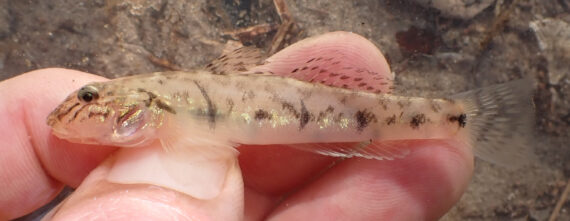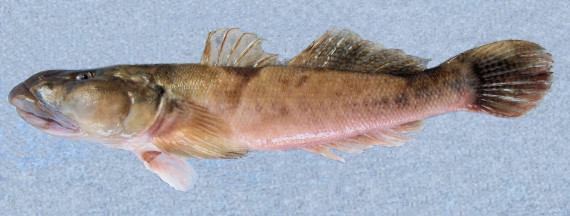River Goby, Awaous banana
 River Goby, Awaous banana, Juvenile. Fish caught from the San José River, Baja California Sur, March 2022. Length: 7.6 cm (3.0 inches). Catch, photograph and identification courtesy of Luke Ovgard, Klamath Falls, Oregon.
River Goby, Awaous banana, Juvenile. Fish caught from the San José River, Baja California Sur, March 2022. Length: 7.6 cm (3.0 inches). Catch, photograph and identification courtesy of Luke Ovgard, Klamath Falls, Oregon.
 River Goby, Awaous banana, Juvenile. Fish caught from the coastal freshwater system in the greater Sebastian, Florida area, March 2023. Length: 7.8 cm (3.1 inches). Catch, photograph and identification courtesy of Ben Cantrell, Sebastian, Florida.
River Goby, Awaous banana, Juvenile. Fish caught from the coastal freshwater system in the greater Sebastian, Florida area, March 2023. Length: 7.8 cm (3.1 inches). Catch, photograph and identification courtesy of Ben Cantrell, Sebastian, Florida.
 River Goby, Awaous banana. Fish collected at the mouth of the San José River, Baja California Sur, July 2005, by locals using a cast net, during a breach in the barrier caused by Hurricane Hilary. Length: 10.5 cm (4.5 inches).
River Goby, Awaous banana. Fish collected at the mouth of the San José River, Baja California Sur, July 2005, by locals using a cast net, during a breach in the barrier caused by Hurricane Hilary. Length: 10.5 cm (4.5 inches).
 River Goby, Awaous banana. Fish collected at the mouth of the San José River, Baja California Sur, July 2005, by locals using a cast net, during a breach in the barrier caused by Hurricane Hilary. Length: 22.0 cm (8.7 inches). Note the extensive elongation of the snout in this larger fish.
River Goby, Awaous banana. Fish collected at the mouth of the San José River, Baja California Sur, July 2005, by locals using a cast net, during a breach in the barrier caused by Hurricane Hilary. Length: 22.0 cm (8.7 inches). Note the extensive elongation of the snout in this larger fish.
The River Goby, Awaous banana, is a member of the Goby or Gobiidae Family, and is known in Mexico as gobio de río. Globally, there are thirteen species in the genus Awaous, one of which is found in Mexican waters, this species which is found both in the freshwater systems that feed both the Atlantic and the Pacific Ocean.
The River Goby has a robust elongated rounded body with a flat ventral side. They have an overall tan to brown coloration that transitions to pale yellow and white ventrally. Their head has 3 black slanted bars and their body has seven irregular black bars on the upper sides; the first bar extends from above the gill cover onto the pectoral fin and the bar under the origin of the dorsal fin is crescent-shaped. Their flanks have 7 or 8 black blotches and their back has a series of irregular small spots. Their anal and pelvic fins are pinkish; their caudal fin has 7 or 8 dark bars; their dorsal fin is yellowish; and their pectoral fin has a black bar at the front and its base is pinkish-orange. Their head is depressed and broader than it is deep and has a blunt snout, a moderately-sized inferior mouth with large fleshy lips, and small eyes set very close together on top of the head. Their caudal fin is rounded; their first dorsal fin has 6 spines; their second dorsal fin has 1 spine and 9 to 12 rays; and their pelvic fins are fused into a disc. They are covered with rough scales and do not have a lateral line.
The River Goby is found in clear streams and rivers over sand and gravel at depths up to 3 m (10 feet). They reach a maximum of 37 cm (15 inches) in length. They consume aquatic insects, foraminifers, and plant materials. They spawn in the ocean, with the larvae being pelagic and becoming widely dispersed. Juveniles quickly return to fresh water; adults and juveniles spend most of their time in fresh to brackish water. They prefer water temperatures between 25°C (77°F) and 30°C (86°F). The River Goby is a shallow-water species that is poorly studied with very limited information available about their lifestyle and behavioral patterns including specific details on age, growth, longevity, movement patterns, diet, habitat use, and reproduction.
The River Goby is a resident of all Mexican freshwater rivers of the Atlantic and the Pacific with the exception that they are absent from northwest coast of Baja and from the northern half of the Sea of Cortez.
The River Goby is not easily confused with any other species from the Atlantic. In the Pacific it is fairly similar in appearance and might be confused with the Cheekspot Goby, Ilypnus gilberti (black chin; anal fin with dark stripe), the Guaymas Goby, Quietula guaymasiae (uniform gray color), the Longjaw Mudsucker, Gillichthys mirabilis (rows of dark blotches on flanks), and the Shadow Goby, Quietula y-cauda (rows of dark spots on flanks).
From a conservation perspective the River Goby has not been formally evaluated. They are a target of subsistence fishermen in the greater San José del Cabo, Baja California Sur area during rare breaches in the dyke separating the San José River from the Sea of Cortez, however, they are of limited interest to most.